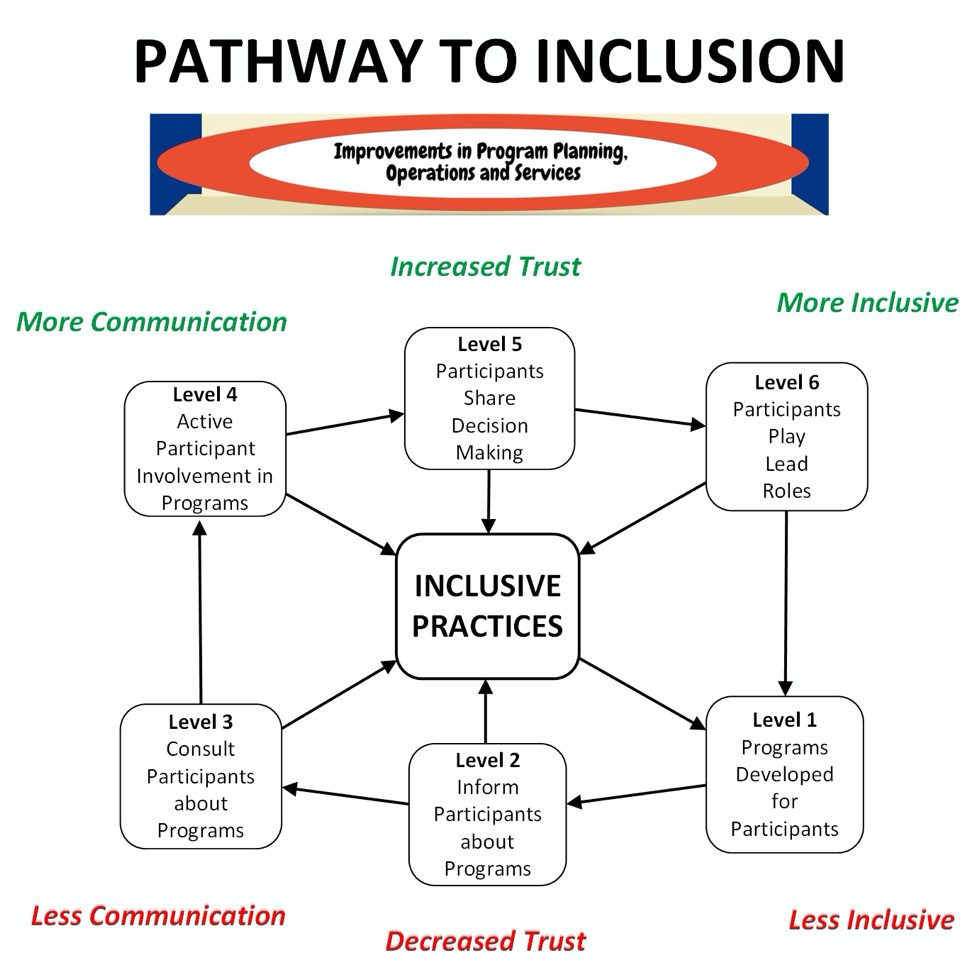
The Pathway to Inclusion is a graphic tool that organizations can use to distinguish between the types of active and meaningful inclusive activities in their programs and their communities. Through inclusive discussions with program participants (see Definitions), partners, and stakeholders using the Pathway, organizations can conduct balanced, well-informed, consistent reviews to determine a projects overall placement on the Pathway at specific time intervals (quarterly). The purpose of inclusive activities is to lead to improvements in program planning, operations and services, as shown at the top of the Pathway.
The Pathway to Inclusion includes 6 levels:
Level 1: Programs Developed for Participants – Little or no involvement of participants. Few programs are ever at Level 1, but without programs developed for participants, there is no need for additional inclusion. Level 1 is a context, and it is unlikely that any program will succeed without some participant inclusion.
Level 2: Inform Participants About Programs – Programs provide information to current and potential participants about programs. At this level communication is generally one-way (from program to participant).
Level 3: Consult Participants about Programs – Programs engage in individual or group discussions or data collections (surveys, focus groups, community meetings) to collect information from participants about current services, unmet needs, and potential services.
Level 4: Active Participant Involvement in Programs – Participants, through advisory, steering committees, or other activities play active roles in planning and program activities.
Level 5: Participants Share Decision Making – Participants share in the process of making decisions regarding planning and operations of programs.
Level 6: Participants Play Lead Roles – Individual participants who are not representing partner organizations but are current or potential program participants take on leadership roles in program planning and operations.
Generally speaking,
- Lower levels on the Pathway (Levels 1-3) have less communication, decreased trust, and are less inclusive.
- Higher levels of the Pathway (Levels 4-6) have more communication, increased trust, and more inclusive.
- The Pathway is a continuum, as demonstrated by the clockwise progression from lower levels of inclusion to higher levels. At any given period of time, programs are likely to be conducting activities that continue to be necessary for planning and operations, as is demonstrated by arrows leading from all levels except Level 1 to Inclusive Practices.
- The Pathway is not one way, since during a given period of time programs may or may not have examples of participant inclusion.
- For an organization to become more inclusive, it is likely that over time more and more examples of higher levels of inclusion will develop.
In order to maintain higher overall levels of inclusion, an effective inclusive program will be able to provide a number of examples of inclusive activities at different levels that cumulatively make the program more inclusive.
Resources about the Pathway To Inclusion
- Presentation by Dr. Bernstein at the 2020 annual conference of the American Evaluation Association. It presents lessons learned about inclusive planning involving people with disabilities, older adults, and caregivers.
- Presentation by Dr. Bernstein at the Transit Planning 4 All Forum during the 2022 CTAA Expo in Louisville, Kentucky. Dr. Bernstein discusses the process of inclusive planning, the creation and evolution of the pathway and explores how and where planning activities land on the Pathway to Inclusion.
